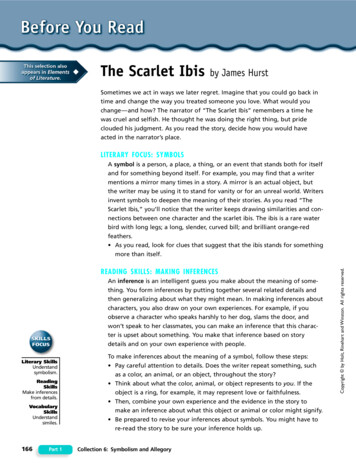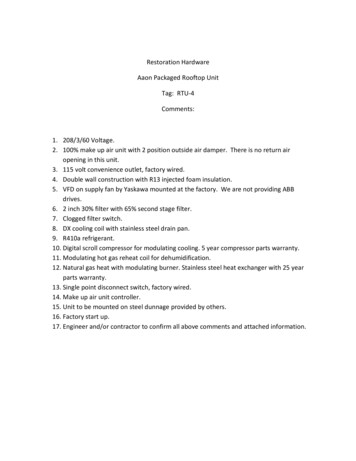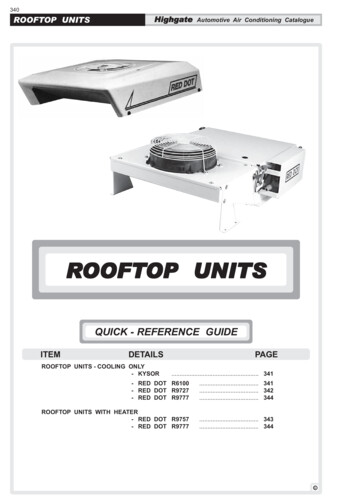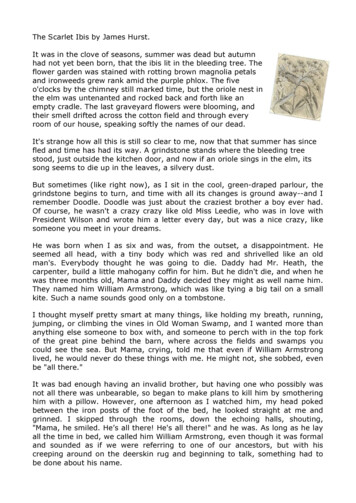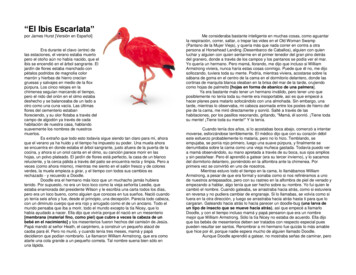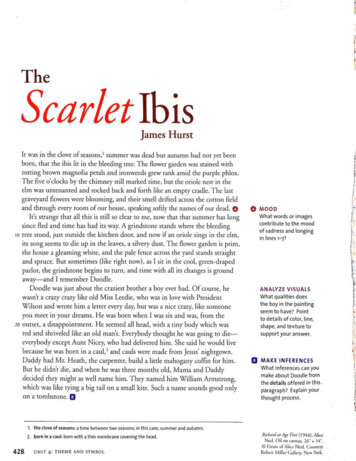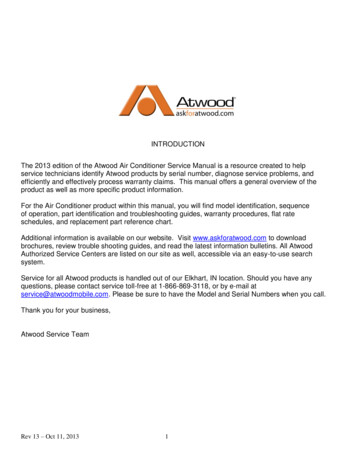
Transcription
INTRODUCTIONThe 2013 edition of the Atwood Air Conditioner Service Manual is a resource created to helpservice technicians identify Atwood products by serial number, diagnose service problems, andefficiently and effectively process warranty claims. This manual offers a general overview of theproduct as well as more specific product information.For the Air Conditioner product within this manual, you will find model identification, sequenceof operation, part identification and troubleshooting guides, warranty procedures, flat rateschedules, and replacement part reference chart.Additional information is available on our website. Visit www.askforatwood.com to downloadbrochures, review trouble shooting guides, and read the latest information bulletins. All AtwoodAuthorized Service Centers are listed on our site as well, accessible via an easy-to-use searchsystem.Service for all Atwood products is handled out of our Elkhart, IN location. Should you have anyquestions, please contact service toll-free at 1-866-869-3118, or by e-mail atservice@atwoodmobile.com. Please be sure to have the Model and Serial Numbers when you call.Thank you for your business,Atwood Service TeamRev 13 – Oct 11, 20131
Atwood AirCommand Air ConditionerService ManualTable of ContentsRecommended Tools and Equipment . . .pg 3Model Number Identification . . .pg 3Air Conditioner Parts (Exploded Views of Ducted and Non-ducted units).pg 4-7Service Part Numbers .pg 8Air Conditioner Sequence of Operation .pg 9 -10Thermostat Operation (Lock, Interrogation, Control Parameters). .pg 11-14Troubleshooting Guide (Error Code Test Procedures). . pg 15-16Troubleshooting Guide (Typical Fault Conditions). pg 17-19Recharging Instructions, Generators and Inverters. .pg 20Thermistor Temperature vs Resistance Table. .pg 21Specification Listing. . .pg 22Schematic Diagram . .pg 23 -24Pictures . .pg 25-26Rev 13 – Oct 11, 20132
Recommended ToolsCommon Hand Tools:1/8” and 1/4” nutdriversOpen end wrenchesFlat blade and Philips screwdriversPacking knifeDigital MultimeterCapable of measuring continuity and AC & DC voltagesDigital Thermocouple ThermometerCapable of measuring temperature with 2 thermocouplesMegohmmeter (megger)Capable of checking for ground leakage paths.Model Number DescriptionAC – 1351 WColorW - WhiteB - BlackGeneration1 - First GenerationPower rating & Ducted/Non-Ducted135 – 13.5K BTU; Non- Ducted AC (Air Conditioner)136 – 13.5K BTU; Ducted AC (Air Conditioner)150 – 15.0K BTU; Non-Ducted HP (Heat Pump)151 – 15.0K BTU; Ducted HP (Heat Pump)Appliance TypeAC – Air ConditionerModel Number/ Part NumberRev 13 – Oct 11, 2013Model NoDescriptionAC - 1351 WAC - 1501 WAC - 1351 BAC - 1501 BAC - 1361 WAC - 1511 WAC - 1361 BAC - 1511 tedDuctedDucted3Atwood Part NoRoof Unit Only1502515026150301503115027150281503215033
Exploded View of Air Conditioner Service PartsAC 1361 - DUCTED COOLINGFig 303132333435363738392627282934393536Rev 13 – Oct 11, 201337384DescriptionBOLT M6 x 25mmSHROUDCANOPY REINFORCING STRAP RHCANOPY REINFORCING STRAP LHEVAP HOUSING STRAPEVAP HOUSING UPPEREVAP MOTOR STABILIZING BRACKETEVAP HOUSING LOWEREVAP FANEVAP MOTORCOMPRESSOR STABILIZING BRACKETCOMPRESSOR, LG(A), RECHI (B)MOTOR MOUNT BRACKETFAN MOUNTING SUPPORTCONDENSOR FAN MOTORCONDENSOR FANCONDENSOR SHROUDCONDENSOR COILCHARGING TUBELIQUID LINEAC CHASSISCONTROL BOXCAPILLIARY ASSEMBLYROOF SEALING GASKET, HOLEROOF SEALING GASKET, REARPLENUM DECK ASSEMBLYHOLD DOWN BARS & BOLTS (incl. DECK ASSY)PLENUM FASCIASCREWS AND COVER PLUGS (incl. FASCIA)CANOPY SCREWS st4 x 16mmWASHERS inner dia. 6mmFILTER/DRIEREVAP COILCONTROL BOARDTERMINAL CONNECTORMOTOR CAPACITOR 10 UFCOMPRESSOR CAPACITOR 50 UFCAPACITOR 112114
Exploded View of Air Conditioner Service PartsAC 1511 - DUCTED HEAT PUMPFig 3031323334353637383926262728293439373536Rev 13 – Oct 11, 2013385DescriptionBOLT M6 x 25mmSHROUDCANOPY REINFORCING STRAP RHCANOPY REINFORCING STRAP LHEVAP HOUSING STRAPEVAP HOUSING UPPEREVAP MOTOR STABILIZING BRACKETEVAP HOUSING LOWEREVAP FANEVAP MOTORCOMPRESSOR STABILIZING BRACKETCOMPRESSOR, LGMOTOR MOUNT BRACKETFAN MOUNTING SUPPORTCONDENSOR FAN MOTORCONDENSOR FANCONDENSOR SHROUDCONDENSOR COILCHARGING TUBELIQUID LINEAC CHASSISCONTROL BOXCAPILLIARY ASSEMBLYROOF SEALING GASKET, HOLEROOF SEALING GASKET, REARPLENUM DECK ASSEMBLYHOLD DOWN BARS & BOLTS (incl. DECK ASSY)PLENUM FASCIASCREWS AND COVER PLUGS (incl. FASCIA)CANOPY SCREWS st4 x 16mmWASHERS inner dia. 6mmFILTER/DRIEREVAP COILCONTROL BOARDTERMINAL CONNECTORMOTOR CAPACITOR 10 UFCOMPRESSOR CAPACITOR 50 UFCAPACITOR 112114
Exploded View of Air Conditioner Service PartsAC 1351 - NON-DUCTED 6272829303132333435363738393634393536Rev 13 – Oct 11, 201337386DescriptionBOLT m6 x 25mmSHROUDCANOPY REINFORCING STRAP RHCANOPY REINFORCING STRAP LHEVAP HOUSING STRAPEVAP HOUSING UPPEREVAP MOTOR STABALIZING BRACKETEVAP HOUSING LOWEREVAP FANEVAP MOTORCOMPRESSOR STABALIZING BRACKETCOMPRESSOR LG (A), RECHI (B)MOTOR MOUNT BRACKETFAN MOUNTING SUPPORTCONDENSOR FAN MOTORCONDENSOR FANCONDENSOR SHROUDCONDENSOR COILCHARGING TUBELIQUID LINEAC CHASSISCONTROL BOXCAPILLARY ASSY.ROOF SEALING GASKET, HOLEROOF SEALING GASKET, REARDUCT ADAPTERDUCTCEILING PLATEPLENUMCANOPY SCREWS st4 x 16mmWASHERS inner dia. 6mmFILTER/DRIEREVAP COILCONTROL BOARDTERMINAL CONNECTORMOTOR CAPACITORS 10UFCOMPRESSOR CAPACITOR 50UFCAPACITOR 112114
Exploded View of Air Conditioner Service PartsAC 1501 - NON-DUCTED HEAT 282930313233343536373839343937353638Rev 13 – Oct 11, 20137DescriptionBOLT m6 x 25mmSHROUDCANOPY REINFORCING STRAP RHCANOPY REINFORCING STRAP LHEVAP HOUSING STRAPEVAP HOUSING UPPEREVAP MOTOR STABALIZING BRACKETEVAP HOUSING LOWEREVAP FANEVAP MOTORCOMPRESSOR STABALIZING BRACKETCOMPRESSOR, LGMOTOR MOUNT BRACKETFAN MOUNTING SUPPORTCONDENSOR FAN MOTORCONDENSOR FANCONDENSOR SHROUDCONDENSOR COILCHARGING TUBELIQUID LINEAC CHASSISCONTROL BOXCAPILLARY ASSY.ROOF SEALING GASKET, HOLEROOF SEALING GASKET, REARDUCT ADAPTERDUCTCEILING PLATEPLENUMCANOPY SCREWS st4 x 16mmWASHERS inner dia. 6mmFILTER/DRIEREVAP COILCONTROL BOARDTERMINAL CONNECTORMOTOR CAPACITORS 10UFCOMPRESSOR CAPACITOR 50UFCAPACITOR 112114
AC-13X1AC-15X1AIR CONDITIONERSHEAT PUMPSSERVICE PARTSAtwood PNDescriptionPicture 7115072150731507715078150791508015081Literature, IOM Non-ductedAC Plenum Kit, Non-ducted, Off WhiteAC Plenum Kit, Ducted, Off WhiteAC Plenum Kit, Non-ducted, WhiteAC Plenum Kit, Ducted, WhiteAC Remote Control – Non-ducted (no Furnace button)AC 120V Field ConnectorAC-1351W – Non-ducted, White Roof Unit OnlyAC-1501W – Non-ducted, White Roof Unit OnlyAC-1361W – Ducted, White Roof Unit OnlyAC-1511W – Ducted, White Roof Unit OnlyAC Wall Thermostat, White – Ducted (with Furnace button)AC-1351B - Non-ducted, Black Roof Unit OnlyAC-1501B – Non-ducted, Black Roof Unit OnlyAC-1361B - Ducted, Black Roof Unit OnlyAC-1511B –Ducted, Black Roof Unit OnlyAC Wall Thermostat, Black - Ducted (with Furnace button)AC Top Shroud, WhiteAC Top Shroud, BlackAC Condenser Fan MotorAC Evaporator Fan MotorAC Condenser FanAC Evaporator FanAC Compressor, LG, 15K OnlyAC Compressor, Rechi, 13.5K OnlyAC Run Capacitor, Rechi, 13.5K OnlyAC Run Capacitor, LG, 15K OnlyAC Inside FiltersAC Installation Kit, Hold Down ClampAC Remote Control – Ducted (with Furnace button)Extender cable, 13ft length (for some ducted units only)Communication cable, 20ft length (for ducted units only)AC Electrical Kit, Non-ducted unitsLiterature, IOM DuctedControl Board, Non-ducted, AC-1351Control Board, Non-ducted, AC-1501Control Board, Ducted, AC-1361 and AC-1511Not shownNot shownNot shownNot shownNot shownNot shownNot shownNot shownNot shownNot shownNot shownNot shownNot shownNot shownNot shownNot shownNot shown2215101691212373732Not shownNot shownNot shownNot shownNot shownNot shown343434Rev 13 – Oct 11, 20138
Air Conditioner Sequence of OperationVERIFYING NORMAL OPERATION1. Turn the power on at the circuit breaker and verify 110VAC between neutral (N) and Line (L).Only on modelsAC-1501/AC-1511Figure 2Refer to the schematic in Figure 2 for steps 2-6.2. Press the ON/OFF button and press the MODE button to select FAN3. Cycle through the LO, MED and HIGH fan speeds checking that all speeds run.On HIGH speed – verify that 110VAC is output to the HF terminal with respect to neutral (N).On MED speed – verify that 110VAC is output to the MF terminal with respect to neutral (N).On LOW speed – verify that 110VACis output to the LF terminal with respect to neutral (N).4. Set mode to COOL, and adjust temperature setting via up/down buttons to approx 6 F (3 C) less than the displayedtemperature (ie. room temp). The compressor will start within three minutes.Verify 110VAC on the COMP terminal on the control board. If there is no power on COMP terminal –then check the LIVE terminal on the board as shown in Fig 2. If 110VAC is present then the board maybe defective; if not present check AC supply to unit.5. For heat pump models AC-1501/AC-1511, set mode to HEAT, and adjust the temperature setting to approx. 6 F(3 C) above displayed (room) temperature. The compressor will start within three minutes.Verify 110VAC on the COMP terminal on the control board with respect to neutral (N).Verify 110VAC on the 4WV terminal (to change the refrigerant flow in heat pump mode).Verify 110VAC on one of the fan terminals (based on the fan setting); warm air should be present.6. For air conditioner models AC-1351/AC-1361, set mode to HEAT, set temp setting to 6 F (3 C) above thedisplayed (room) temperature. The furnace will start within three minutes.Verify 12VDC on the HTR LIVE terminal (from the furnace) and, when energized, 12VDC should alsobe on the HTR terminal (going to the furnace) on the control board in Fig 2.Rev 13 – Oct 11, 20139
Air Conditioner Sequence of Operation (cont.)7. A functioning air conditioner should be able to create a temperature difference between the incoming airand the outgoing air. Specifically, in an air conditioner the outgoing air should be 20⁰F-30⁰F (11⁰C-17⁰C) cooler thanthe incoming air and in a heat pump the outgoing air should be 20⁰F-30⁰F (11⁰C-17⁰C) warmer than the incomingair.Note: Regardless of the mode selected there will always be at least a 3 minute delay before the compressor starts.VERIFYING THERMISTER OPERATIONthThere are 3 thermistor sensors in an air conditioner and a 4 thermistor sensor in heat pump only applications.1) Indoor coil sensor - labeled ID on the control board and color coded YELLOW2) Outdoor coil sensor – labeled OD on the control board and color coded RED3) Return air sensor – labeled RM on the control board and color coded WHITE4) Outdoor air sensor – labeled OA on the control board and color coded BLACK (available only on AC-1501/1511)Each thermistor can be verified by measuring its resistance (out of circuit) and comparing the resistance value to thecorresponding temperature value listed in the Table 1 near the back of this manual. A detailed troubleshooting methodfor measuring each thermistor’s resistance is described in detail in the “Error Codes & Troubleshooting” section.In addition, the temperature of each thermistor can be read on the thermostat control assembly by placing the control inthe INTERROGATION mode and using TABLE 2 to read each thermistor directly. This is described in detail under theTHERMOSTAT OPERATION section and again under E4 of the ERROR CODES & TROUBLESHOOTING section.VERIFYING CONTROL BOARD CONFIGURATIONThere are 2 jumper locations labeled S1 and S2 on the control board (refer to Fig 2 above). These jumpers allow thecontrol board to be configured for the application. By jumpering pins 1 and 2 on S1, the board is configured as “coolingonly”. By jumpering pins 2 and 3 on S1, the board is configured as a “heat pump”. By jumpering pins 1 and 2 on S2, theboard is configured with the furnace function off. By jumpering pins 2 and 3, the board is configured with the furnace on.Rev 13 – Oct 11, 201310
Thermostat OperationInfra red receptionTemperature displayareaSENSORTo receive wireless handset sign alOn/Off buttonON/OFFDisplay timer setting, set or ro omtemperature in C or FRoom temperaturesetting buttonTimer buttonTEMPPress to activate on/offtimer programming ss once to start operationPress again to stop operationMode buttonMODEPress to select cool, dry, heat ,fan, or auto operation modeSleep buttonSLEEPPress once to select sleep modePress again to cancel sleep modeFan speed buttonKey lockPress to select auto, high,medium or low fan speedFurnace buttonThis button is valid in heatpump furnace model onlyPress once to select furnace asprimary heatingPress again to cancel furnace asprimary heatingNOTE: Furnace button onlyavailable on Ducted ModelsTEMPERATURE DISPLAY The 2 –digit LED display normally displays the Set Temperature EXCEPT when the SLEEP button is pressed orthe control is LOCKED and in the interrogation mode. To display the room temperature, pressSLEEPbutton for 5sec or longer. While this button is depressed, theroom temperature is displayed until the key is released. Given the lack of display characters - if the control isdisplaying temperature in Fahrenheit, temperatures of 100-109 F will be displayed as A0 –A9, temperaturesbetween 110-119 F will be displayed as B0-B9, temperatures between 120-129 F will be displayed as C0-C9,temperatures between 130-139 F will be displayed as D0-D9, temperatures between 140-149 F will be displayedas E0-E9, and temperatures between 150-159 F will be displayed as F0-F9. Temperatures are displayednormally in degrees Centigrade. To change from Centigrade to Fahrenheit display, press thePress theandFANandFANbuttons together for 5 seconds.buttons together again for 5 seconds to change back from Fahrenheit to Centigrade.LOCK MODE The LOCK mode is provided to prevent unauthorized access to the system settings To enter LOCK mode with the control system on, hold downactivate the key lock function, key lock symbolkey lock functionRev 13 – Oct 11, 201311andMODEbuttons for 3 seconds towill light up. Repeat the same sequence to cancel
INTERROGATION MODE To enter the INTERROGATION mode, the control must be in LOCK mode. See above. The INTERROGATION mode allows a person to access the temperature measurements of varioussensors throughout the system as well as directly control the air conditioner.ON/OFFoPressing theoTo access the sensors, hold downpushbutton will start or stop the air conditioner.andSLEEPbuttons for 1 second to activate sensortemperature display function. The control flashes an LED to identify which sensor’s temperatureis being displayed as given in table 2 below. Pressorbutton to select the desiredsensor temperature. The displayed temperatures range from 19⁰F to 172⁰F (–9⁰C to 78⁰C).oTo exit this mode, hold down theandSLEEPbuttons for 1 second to de-activate sensortemperature display function.TABLE 2 – INTERROGATION MODE TABLENoMenuLED IndicationRemarks1Indoor coil tempAuto fan flashing2Outdoor coil tempHigh fan flashing3Outdoor air tempMedium fan flashing4Main board room tempLow fan flashing5Wall pad room tempAuto and high fanflashing6AC voltage supplyAuto and medium fanflashingVoltage available shows “AC”else “- -“7Fan control in furnaceprimary heatingAuto and low fanflashingFan on shows “F0” else “FF“Rev 13 – Oct 11, 201312
CONTROL SYSTEM PARAMETERS This mode allows a person to view and CHANGE the control system parameters. Care must be takennot to change these values unless under strict supervision by a trained Atwood service technician. To display the control system parameters, hold downandFANbuttons for 1 second to activatethe system control parameter programming. To select a different parameter to be displayed as listed inTABLE 3 below, press MODEbutton.To CHANGE a parameter setting press and hold theTo exit this mode, hold downFANandorbuttons.buttons for 1 second to de-activate the system controlparameter programming.TABLE 3 – CONTROL SYSTEM PARAMETERSNoMenuLED IndicationRangeRemarks1Defrosttermination tempAuto fan flashing,Sleep off50⁰F - 59⁰F,default 50⁰F(10⁰C - 15⁰C, default 10⁰C)2Heat pumpinhibit temp, ThpHigh fan flashing,Sleep off32⁰F - 50⁰F,default 44⁰F(0⁰C - 10⁰C, default 7⁰C)3Defrostdifferential, TdMedium fan flashing, 41⁰F - 68⁰F,default 46⁰FSleep off(5⁰C - 20⁰C, default 8⁰C)4Defrost intervalTM1Low fan flashing,Sleep off68⁰F-302⁰F,default 131⁰F min(20⁰C-150⁰C, default 55⁰C min)Value 99 is shown inhexadecimal format5Defrost intervalTM2Auto and high fanflashing68⁰F-302⁰F,default 104⁰F min(20⁰C-150⁰C, default 40⁰C min)Value 99 is shown inhexadecimal format6Defrost mode,DmAuto and mediumfan flashing34⁰F - 36⁰F,default 36⁰F(1⁰C - 2⁰C, default 2⁰C)1: Outdoor air & coil differential,2: Coil temperature only.Outdoor air temp to inhibit heatpump operationERROR CODE DISPLAY Should there be any fault happen with the main board, the relevant error code will be shown on thetemperature display area. If there multiple faults happen at the same time, the error codes will be shown one after another. System will alternate the display of error codes and the room temperature. Error codes are listed in the Table 4.Rev 13 – Oct 11, 201313
TABLE 4 – ERROR CODESFaultError codeRoom sensor failureE1Indoor coil sensor failureE2Outdoor coil sensor failureE3Insufficient of refrigerantE4Compressor overloadE5Not UsedE6Not UsedE7Outdoor air sensor failureE8Wall pad room sensor failureE9INFRARED SIGNAL RECEPTION The system is able to receive the infrared wireless commands from non-LCD handset.MASTER-SLAVE OPERATION It is possible to control the air conditioner in a master-slave relationship if the wall pad is connected to agateway card. If the master controller is working in global control mode, the key lock LED flashes on the wall pad.None of the button or infra-red reception will be acknowledged until the master controller gives upglobal control mode.Rev 13 – Oct 11, 201314
ERROR CODES & TROUBLESHOOTINGE1: Room sensor fault.Action:Usually this is a faulty connection (plug), damaged lead or a faulty sensor.First verify that the White plug is connected to the socket on main board labeled“RM”. Disconnect the White plug and measure the resistance of the thermistorwith a digital multimeter as shown in Fig 19. With a thermocouple connected to adigital thermocouple reader, place the thermocouple next to the thermistorsensor to identify the “expected” temperature that thermistor is measuring.Compare the measured resistance value with the expected value in Table 1.If the thermistor is more than 9⁰F (5⁰C) out of calibration then replace thethermistor. When replacing the thermistor, install the cable so that it extendsdownward from the copper pocket on the coil.E2: Inside coil sensor fault. Usually this is a faulty connection (2 plugs), damaged lead or a faulty sensor.Action:First verify that the Yellow plug is connected to the socket on the main boardlabeled “ID”. Disconnect the Yellow plug and measure the resistance of thethermistor as outlined in E1 above and replace the thermistor if necessary.Attach the thermocouple to the coil next to the thermistor sensor (ref Fig 22)E3: Outside coil sensor fault. Usually this is a faulty connection (2 plugs), damaged lead or a faulty sensor.Action:First verify that the Red plug is connected to the socket on the main boardlabeled “OD”. Disconnect the Red plug and measure the resistance of thethermistor as outlined in E1 above and replace the thermistor if necessary.Attach the thermocouple to the coil next to the thermistor sensor (ref Fig 21)WHITE connector in socket labeled RMRED connector in socket labeled ODYELLOW socket labeled IDYELLOW connector from socket labeled ID,resistance of thermistor being measuredwith multimeterFIG 19Rev 13 – Oct 11, 201315
ERROR CODES & TROUBLESHOOTING (cont):E4: Indicates either a lack of refrigerant, the compressor is not running, or the thermistor is out of calibration.Action:Check that the compressor is running by listening. If it is apparent that the compressor isrunning, then check the temperature differential across the evaporator by measuring thetemperature of the return air at inlet filters and measuring the temperature of thedischarge air at the grilles. This temperature differential should be between 25⁰F and32⁰F (14⁰C and 18⁰C) with the fan set on HI speed. If the temperature differential is lessthan 25⁰F (14⁰C), the reason could be a lack of refrigerant or a faulty thermistor. Pleasecheck the actual thermistor temperature on the coils with the following procedure.Procedure for Measuring Coil Temperatures Using the Control Panel:1) Set the inside fan to run on HI.2) While pressing and holding the TEMP DOWN pushbutton, press the MODEpushbutton.3) Continue pressing both pushbuttons for approximately 5 seconds until the amberLOCK LED illuminates (next to the Key symbol). Release both pushbuttons.4) Then press and hold both the TEMP DOWN and the SLEEP pushbuttons togetherfor about 1 second until the green MED SPEED LED is flashing. Release bothpushbuttons. The display is now reading the temperature of the outside coil.5) Then press the TEMP UP pushbutton once. This should result in the green HISPEED LED flashing. The display is now reading the temperature of the inside coil.This temperature will usually be between 41⁰F and 53⁰F (5⁰C and 12⁰C).6) The temperature differential between the outside and inside coils should be less than25⁰F (14⁰C). If this temperature differential is 25⁰F (14⁰C) or greater, the thermistormay be out of calibration. Measure the resistance of the thermistor as outlined in E1above and replace the thermistor if necessary. Note: A temperature differentialgreater than 43⁰F (24⁰C) can also be caused by a lack of refrigerant.E5: If this message is displayed during the Heating mode, it indicates that the inside coil is too hot.If this message is displayed during the Cooling mode, it indicates that the outside coil is too hot.Action:During cooling, the E5 will appear if the outside coil temperature exceeds 154⁰F (68⁰C).This is an indication that the condenser air flow severely reduced or non-existent. Step 4in the above procedure describes how to display the temperature of the outside coil. Iffans are running and the E5 message is still displayed, verify the thermistor operation asoutlined in E3 above. If fans are running and the thermistor is verified, then replace themain control board.E6,E7: These codes are not implemented in this system. If present, then change the main control boardE8: This indicates an outdoor air sensor failure. This is usually a faulty connection (2 plugs), damaged lead ora faulty sensor.Action:Measure the resistance of the thermistor as outlined in E1 above and replace thethermistor if necessary.E9: This indicates a wall pad room sensor.Action:Rev 13 – Oct 11, 2013Replace wall mounted thermostat assembly.16
When attempting to diagnose a fault over the phone, please ask the following questions.Also it is usually possible to direct the customer to extract thermistor temperature data as describedbefore. This can make fault finding more accurate.1: Is there now or have there been any error codes displayed?2: Does the display board appear normal? Are the displayed temperatures between 61⁰F and 86⁰F(16⁰C and 30⁰C)?3: In heating or cooling modes, can the displayed temperatures be altered via the up /down buttonsfrom 61⁰F to 86⁰F (16⁰C to 30⁰C)?4: Is the display showing “0”?5: Is the display showing an unusual figure?6: When the unit is set to “FAN” only, does the inside fan have 3 speeds? Does the inside fanblow air?7: Can the compressor be heard running?Error codes are important clues. Refer to preceding pages.Extracting coil temperatures via the display is also vital in many diagnoses.A broken control cable or displaced plug of the control cable will result in either the display being blank ordisplaying a “0”.If an unusual figure is displayed, it might be attributed to the vehicle’s DC power supply or the vehicle’s DCconverter being out of adjustment.Typical faults or complaints1: Any complaint accompanied with an error code, see earlier pages.2: Unit will not work and no display is evident.Check the following in order:a. Verify that the main ECB breaker is set to ONb. Verify that AC power is present at the output from the ECBc. Verify that the 4-wire control cable is plugged into the thermostat module in the insideplenum. Reference Fig 23.d. Verify the AC power connection at the underside of unit.e. Verify that the AC fuse is not blown on the main board. NOTE: A faulty fan motor can causea blown fuse.f. Verify all electrical connections on the main board.a. Verify that the power supply is functioning correctly by checking the voltages at thebreakaway plug between the control cable and the display in the plenum. If the DCvoltage is not present, a faulty power supply is likely the reason.3: Unit drops out the ECB breaker:Use a 500V megohmmeter (megger) to check for ground leakage. A reading of 10Megohm or greaterindicates no ground leakage; a reading of less than 10Megohm indicates a faulty component.Disconnect each AC load (such as the fan motor, the compressor, etc.), one-by-one until a reading of10Megohm or greater is obtained. The last load disconnected is the faulty component to be replaced.4: Compressor will not start:Check that the control board is outputting to the compressor.(yellow wire from compressor relay).Use a clamp ammeter to check for current to compressor. Continuous current above 14 ampsindicates a faulty compressor. Check winding continuity with a digital multimeter.Typical measurements for the compressor are as follows:Main Winding: 0.8 ohmsStart Winding: 2.1 ohmsResistance to earth: Minimum 20 Meg Rev 13 – Oct 11, 201317
Typical faults or complaints (cont)5: During the cooling mode, the compressor stops.In this fault condition the unit ceases to cool but the display temperatures indicates a very cool value perhaps as low as 50⁰F (10C). This is typical of an inside coil icing up. The thermistor detects that thecoil is at or below zero and turns off the compressor until temperature rises to 53⁰F(12⁰C), whereuponthe compressor will restart. This situation is usually associated with the unit running for a prolongedperiod on low fan speed particularly in high humidity conditions. This problem can usually be resolvedby running the unit on a higher speed in the “Manual” mode and not using the “Auto” fan setting.Check also that the return air filters are clean.6: During heating mode, the unit stops heating, fan stops, and the red heat LED blinks.This fault condition indicates that the unit has entered the de-ice mode to rid itself of frost on the outsidecoils. The unit will restart automatically in 5 to 10 minutes. It should be noted that if the display tempdrops to a low figure, on resumption of heating, the blinking red light turns to a steady red light, and thefan will be delayed until the inside coil is warmed to 90⁰F (32⁰C). When the inside fan does start theremay be a momentary puff of vapor. This is normal.7: In very cold conditions the compressor can be heard running but the inside fan does not start.Be patient, in very cold conditions the unit needs time to warm sufficiently to start producing warm air.8: Compressor transmits excessive vibration.Check that pipe work is not touching other pipes9: During heating, the unit cycles regularly, the temperature display indicates the room temperature to bebetween 75⁰F and 82⁰F (24⁰C to 28⁰C) however the average temperature in the cabin is much lower.This condition can be caused by a faulty duct which is causing the warm air to short cycle.To see if this is the cause, disassemble the fascia from the inside plenum (4 screws) and examinecarefully the extension duct for leaks, particularly where it joins the horizontal duct.A leaking duct will short cycle warm air onto the return air sensor causing the compressor to closedown prematurely. Repair any leaks and reassemble.10: During cooling, the unit cycles regularly, the temperature display indicates the room temperature to bebetween 71⁰F and 77⁰F (22⁰C and 25⁰C) however the average temperature in the cabin is much higher.This condition can be caused by a faulty duct which is causing the cold air to short cycle.To see if this is the cause, disassemble the fascia from the inside plenum (4 screws) and examinecarefully the extension duct for leaks, particularly where it joins the horizontal duct.A leaking duct will short cycle cold air onto the return air sensor causing the compressor to close downprematurely. Repair any leaks and reassemble.11: Water drips from the inside plenum when the unit is in cooling mode. Ingress of water on cooling modemay be due to either of four conditions.1: The unit is installed more than 5 out of level, particularly nose down.2: The drain holes in the evaporator area are blocked.3: Condensate that has drained onto the roof, has re-entered the installation holeeither under the roof seal of the air conditioner or a roof seam near the unit isfaulty. If case 3 appears likely, the unit should be reinstalled using a newsealing gasket and following the Atwood
135 - 13.5K BTU; Non- Ducted AC (Air Conditioner) 136 - 13.5K BTU; Ducted AC (Air Conditioner) 150 - 15.0K BTU; Non-Ducted HP (Heat Pump) 151 - 15.0K BTU; Ducted HP (Heat Pump) Appliance Type AC - Air Conditioner Model Number/ Part Number Model No Description Roof Unit Only AC - 1351 W Non-ducted 15025 AC - 1501 W Non-ducted 15026
